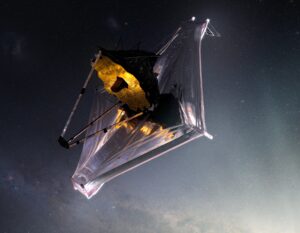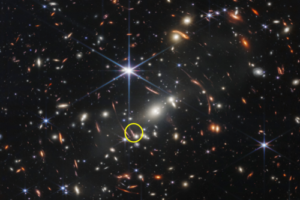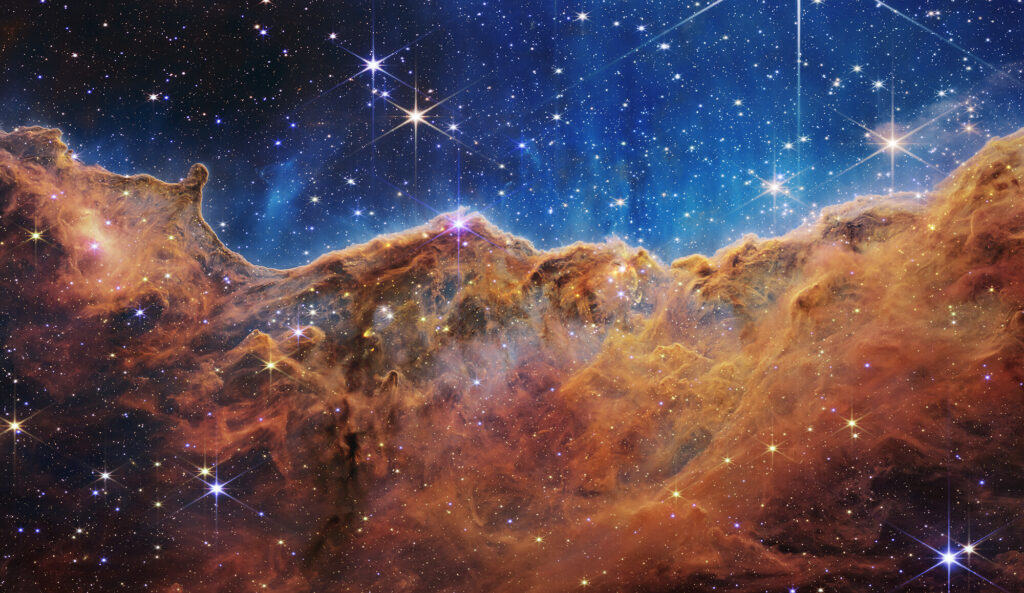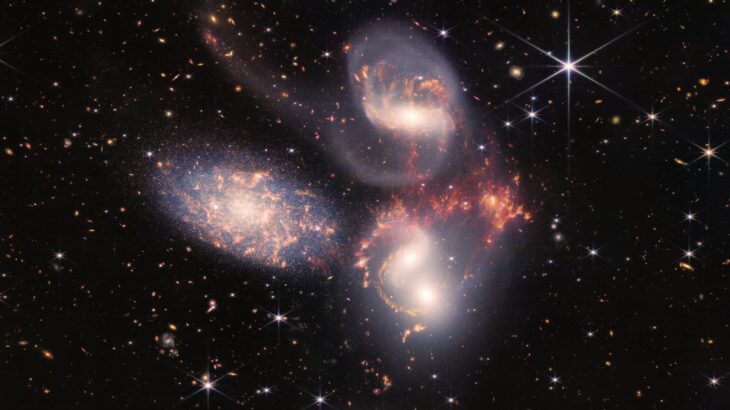By Nada Salem, Physics & Astronomy editor

An artist’s conception of the James Webb Space Telescope floating in space, showing the iconic honeycomb reflective mirror that makes the JWST the most powerful telescope on Earth. The large surface area of the mirror allows it to collect more light from distant objects. The mirror sits on top of a sunshield which protects the observatory instruments from solar heat and keeps its temperature very low. The instruments must operate under -223°C. Image: NASA-GSFC, Adriana M. Gutierrez (CI Lab).
Few events mark the beginning of a new age in astronomy the way that the James Webb Space Telescope (JWST) did last summer. In July 2022, the first full-colour images from the honeycomb-shaped JWST stunned the world. They captured moments from the infancy of the universe beamed from billions of light years away.
The JWST is a time machine
So how do telescopes look back in time? Light takes time to travel! For short distances, light travels too fast for us to notice, which is why it appears that a bulb lights up instantly when we switch it on. But for longer distances, the time it takes for light to reach us becomes more obvious. For example, the average distance between the Sun and Earth is about 150 million kilometres. This means that the Sun’s light takes 8 minutes and 20 seconds to reach us, so what we see is how the Sun looked about 8.3 minutes ago.
When it comes to outer space, we’re often talking about trillions of kilometres. In one Earth year, light travels 9.46 trillion kilometers — we call this distance a light year. So, if we take an image of an object located 9.46 trillion kilometers away, we’re seeing what that object looked like one year ago! In fact, some of the stars we’re imaging were so far away that they no longer exist — the light they emitted billions of years ago has outlived them and is still travelling towards Earth.
The JWST and Canada
An estimated 10,000 people have worked over the last three decades to build the JWST, the highest-resolution telescope ever made. The Canadian Space Agency played a key role in this global mission. This includes the Canada-made Fine Guidance Sensor, the most sophisticated guidance sensor ever built, which acts as the telescope’s navigation system. Canada also contributed the Near-Infrared Imager and Slitless Spectrograph (NIRISS) which captures infrared light and allows scientists to observe distant galaxies and exoplanets, and determine the composition of their atmospheres.
The Sparkler
Soon after the highly anticipated release of its first deep field images, researchers around the world began scouring the JWST’s data to uncover hidden mysteries, including scientists at the Dunlap Institute for Astronomy and Astrophysics at the University of Toronto. In September, they spotted a faraway galaxy in the images that is home to some of the oldest star clusters ever observed. This galaxy is estimated to have been formed just 0.5Gyr (billion years) after the Big Bang, and the images capture how the star clusters looked when the universe was one third of its present age. They named this galaxy the Sparkler, a reference to the red sparkles that piqued their interest when they began investigating the images.

This near-infrared image contains thousands of galaxies, including the Sparkler, circled in yellow, which was investigated by researchers at the University of Toronto. Image: NASA, ESA, CSA, STScI (CC BY 2.0).
To investigate the Sparkler, University of Toronto scientists used the Canadian-made NIRISS, which captures long red wavelengths that are invisible to the human eye. This allows it to detect the faintest objects surrounding the Sparkler. With the help of the NIRISS, researchers determined the Sparkler’s geometry and confirmed that it contains star clusters orbiting around it.
Researchers were also aided by a natural effect called gravitational lensing. Galaxies in the foreground of the image distort anything that lies behind them, including the Sparkler. This distortion magnified the Sparkler by a factor of 100x, revealing details at an even higher resolution. “Our study of the Sparkler highlights the tremendous power in combining the unique capabilities of [the] JWST with the natural magnification afforded by gravitational lensing,” said Chris Willott of the National Research Council’s Herzberg Astronomy and Astrophysics Research Centre in an interview with the U of T news.
Other celestial wonders
The Sparkler is one of many newly observable stars and galaxies that scientists are now examining to find answers about the history of star formation and the origins of the universe. From dying stars to the birth of new ones, the data obtained from the JWST are changing what we know about the earliest phases of the universe. Among many new discoveries, scientists have detected new molecules in the atmosphere of exoplanets and indications of seasonal weather patterns on Titan, one of Saturn’s moons that looks remarkably similar to Earth. Some celestial objects previously labeled as stars have turned out to be distant galaxies. What we thought we knew about the cosmos may be turned upside down as the analysis of new images challenges our theories of the early universe.
The captivating images of glittering celestial landscapes emerging from the JWST data also serve as a reminder of the unfathomable scale of the universe, putting our tiny planet into context.

The Carina Nebula, which contains peaks, cliffs, ridges, and valley, is a stellar nursery. A starfield speckles the entire image. Credits: NASA, ESA, CSA, and STScI (CC BY 2.0).
Looking for a new home
Another goal of the JWST is to identify habitable alternatives to Earth. Before the JWST, our scope for comparing other living conditions to our own was limited to nearby planets, moons, and exoplanets. With the JWST’s high resolution and highly sensitive instruments, we can get a closer look at more distant exoplanets and analyze the chemical compositions of their atmospheres. The sample size for study candidates has expanded enormously and there are already hints of possible hospitable living conditions, or even life, on other planets that we are just beginning to investigate. This doesn’t change the fact that we’re nowhere near close to travelling between solar systems. To reach the potentially habitable TRAPPIST solar system would take 40 years… and that’s at the speed of light!
The JWST has provided us with an unprecedented look at the early days of the universe, shortly after the Big Bang. As scientists analyze data from billions of light years in the past, we will continue to formulate new theories about what we see in space. They may also lead us to reflect on our place in the broad expanse of creation. David Suzuki famously said “we have to recall the image of the planet from outer space: a single entity in which air, water, and continents are interconnected. That is our home.” Until the intergalactic travel of science fiction books becomes a reality, we are stuck on our one little planet that, against all odds, made it possible for life to thrive. And if there happens to be another Earth out there, Science’s favourite time-travelling telescope is our best shot at finding it.
Feature image: One of the first images from the James Webb Space Telescope shows dazzling galaxies interacting with their intersecting gravitational fields — pulling and stretching each another — in high resolution. Image: NASA, ESA, CSA, and STScI (CC BY 2.0).




